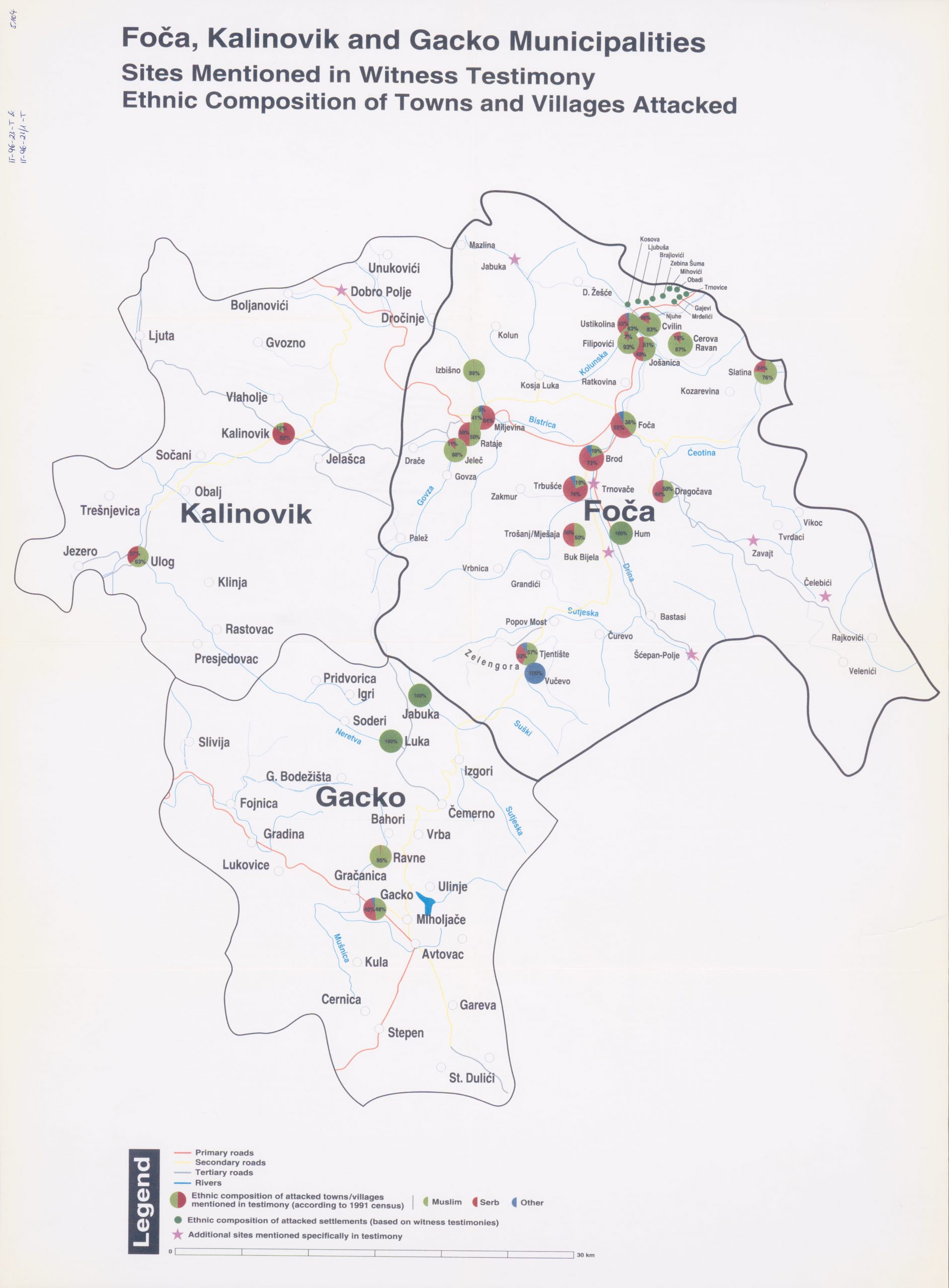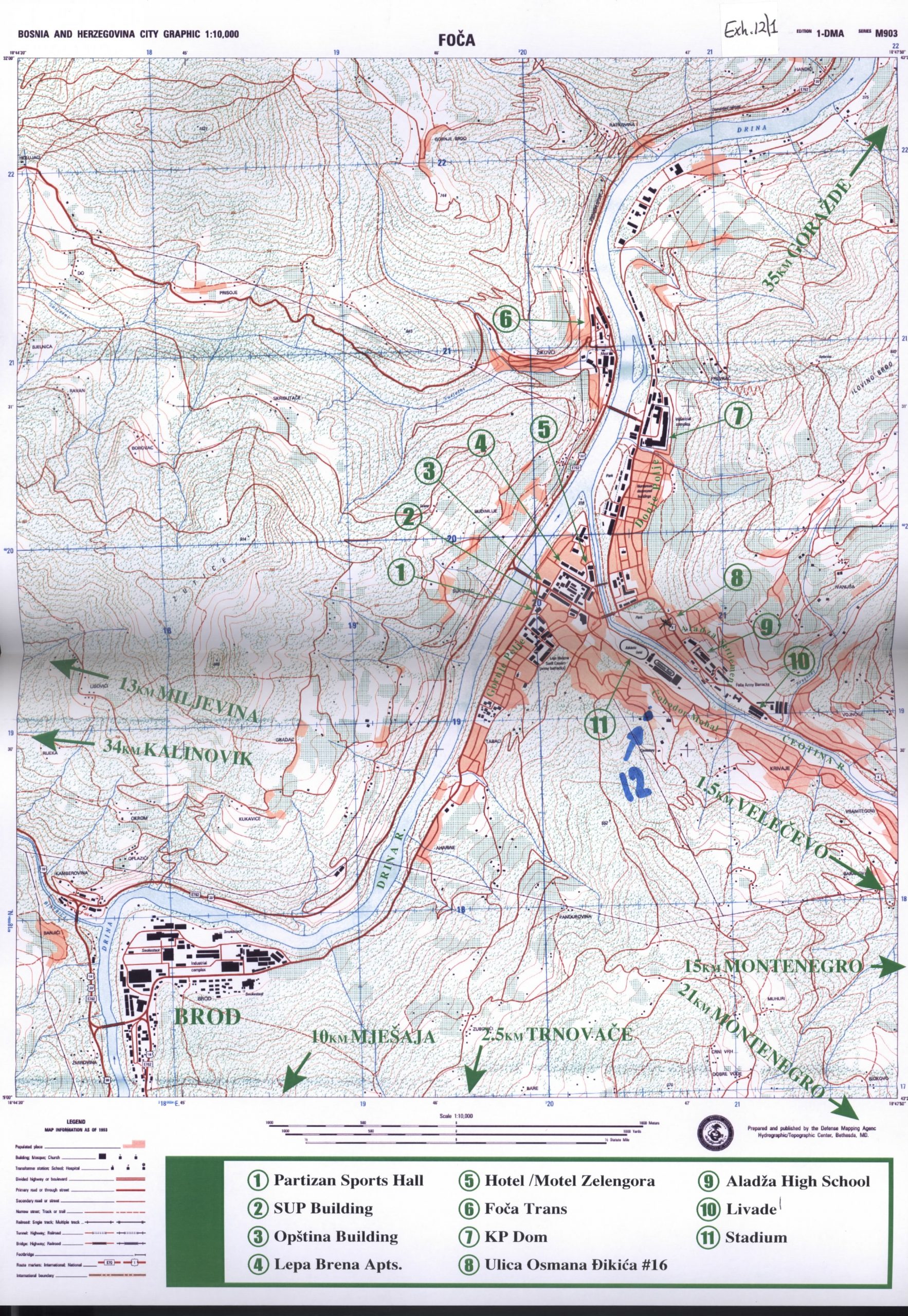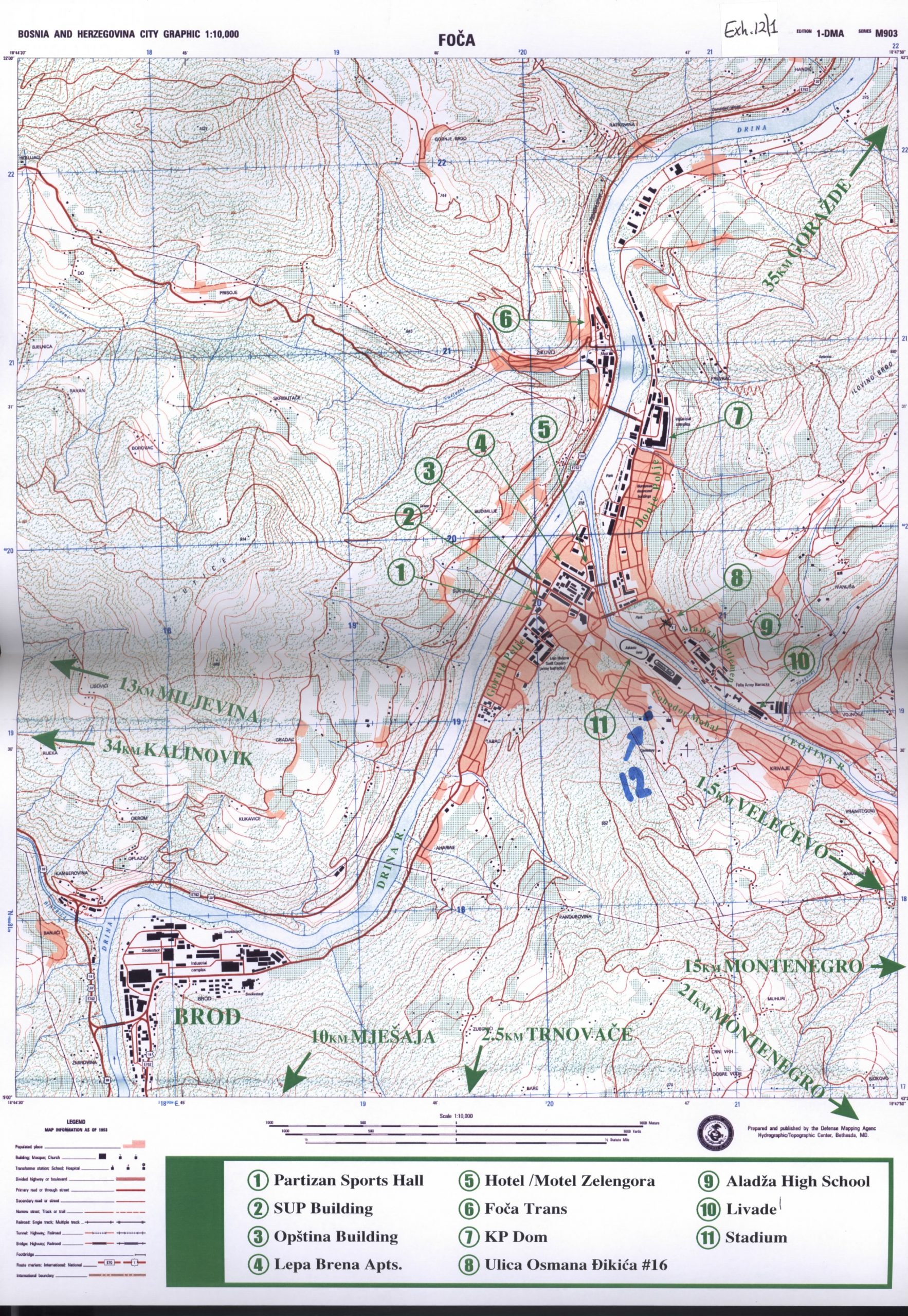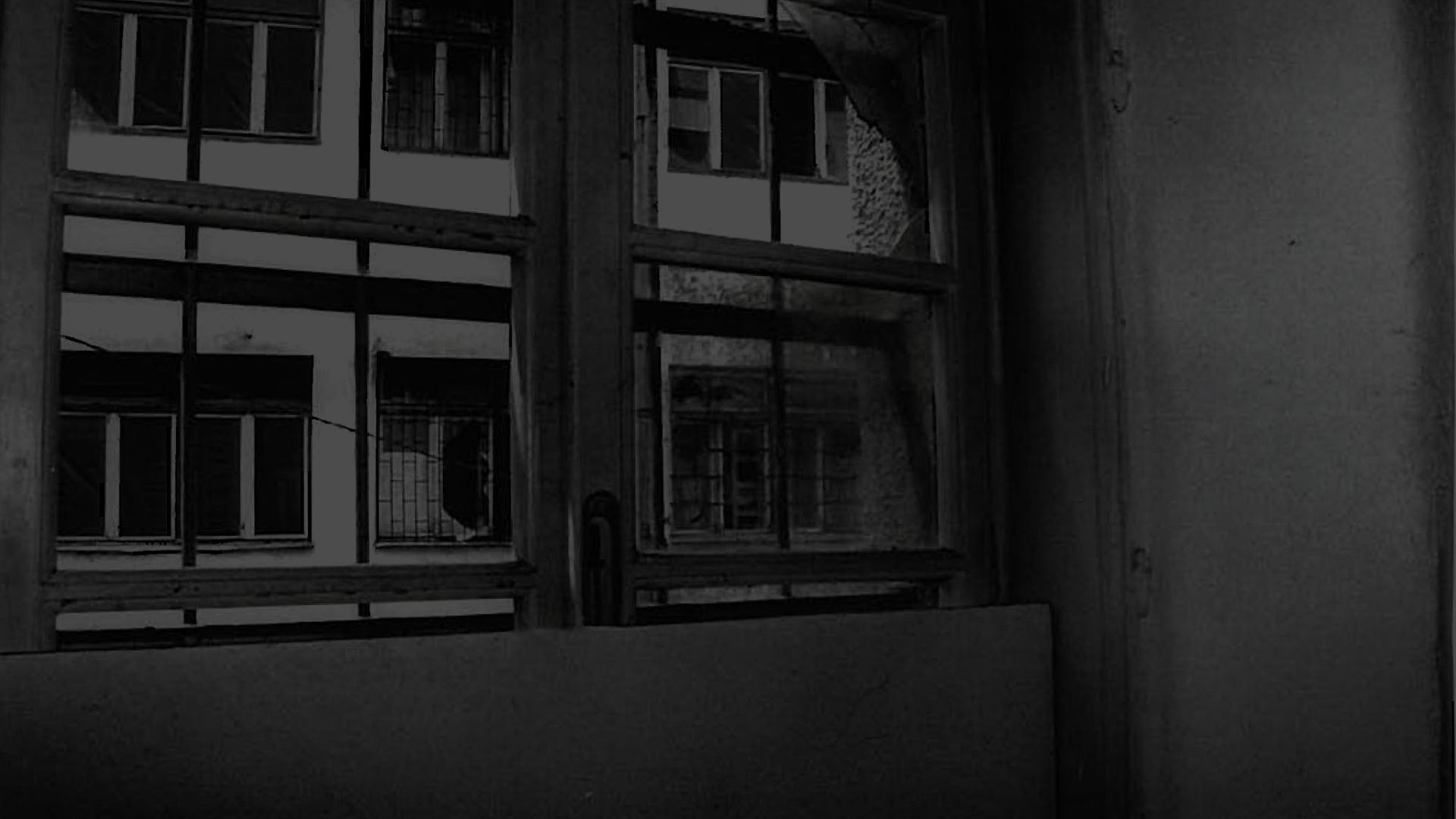
Crimes in Foča in 1992
Foča is a municipality in eastern Bosnia which was populated by about 40,000 inhabitants before the war, of which 52% were Bosnian Muslims, 45% Serbs and 3% Montenegrins. The formation of national parties in 1990 – the Serbian Democratic Party (SDS) and the Party of Democratic Action (SDA, a Bosniak Party) – led to a deterioration of interethnic relations in Foča. In December 1991, municipal government structures were divided on the basis of ethnicity, and Serbian and Bosniak crisis staffs were formed.
Since the beginning of 1992, the inhabitants of Foča had been receiving arms. The local Serbs were armed by the SDS in cooperation with the JNA, whose officers transferred weapons and ammunition from Croatia to Bosnia and Herzegovina, after which the SDS representatives distributed them to the Serbian territorial defence and volunteer units.
Several Bosnian Serb units were established in Foča, including the Foča Tactical Group, whose commander was at first Miroslav Stanić, president of the Serbian crisis staff, and then Marko Kovač, against whom the Prosecution of Bosnia and Herzegovina filed a charge in 2019 for crimes against humanity committed in Foča, and for whom an international arrest warrant has been issued. Stanić and Kovač submitted reports on the situation in Foča and on the Foča Tactical Group to Ratko Mladić, and that unit was transformed into a Republic of Srpska Army (VRS) unit in May 1992.
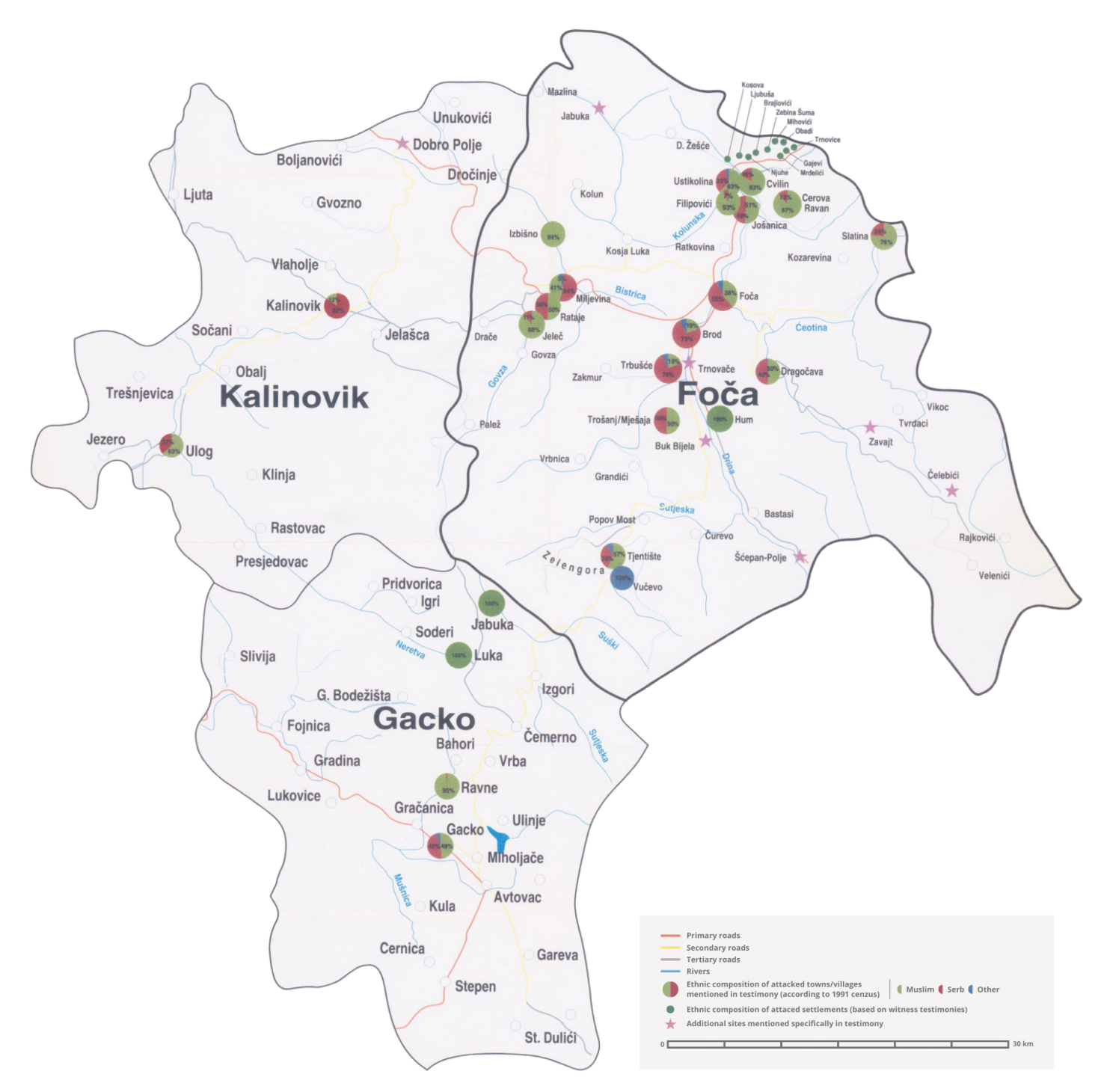
Bosnian Serb forces deployed heavy artillery from across the surrounding hills, and on April 7, 1992, the presence of Serb soldiers was noticeable on the streets of Foča. The Serb forces included local soldiers, as well as soldiers from Serbia and Montenegro, members of the Foča Tactical Group and members of paramilitary formations, including the “White Eagles”. On the morning of April 8, an attack by Serb forces on Foča began, with combined fire from infantry and artillery, aimed mainly at those parts of the city where Bosniaks were in the majority. The armed conflict between the Serb and Bosniak forces in Foča lasted for about a week; and within about two weeks the Serb forces had established complete control over the town.
A large number of civilians, mostly Bosniaks, were injured during the attack on Foča. Many residents of Foča were hiding in basements, and some managed to escape the city. Serb forces looted and set fire to Bosniak houses and businesses during and after the armed conflict, whilst Serb houses were guarded by firefighters.
After Foča fell under the control of Serb forces, Bosniak movement was restricted, telephone lines were cut off, and freedom of assembly was abolished. Many Bosniaks were fired or prevented from going to work. Mass arrests of non-Serb civilians followed, and they were taken to detention facilities operated by the Serbian army (from May 1992: the Army of the Republika Srpska).
Attacks by Serb forces on villages around Foča – Miljevina, Mješaje, Ustikolina, Jeleč, et al. – continued until the beginning of July 1992. The villages were shelled, attacked by infantry and set on fire. Many of the Bosniak residents left their homes in fear and hid in the surrounding forests, where, however, they were soon captured by Serb soldiers. Members of the Serb forces killed several civilians during attacks on villages and captures in forests – at least seven civilians from Mješaje and several civilians from Jeleč. After their capture, most of the women, children and men were taken to detention facilities set up by the Serbian army at several locations in the Foča municipality.
Selection of Documents
Detention facilities for women
A special target of the attack were Bosniak women, many of whom were held as sex slaves in several detention facilities in the Foča area, where they were raped, tortured and otherwise abused and humiliated.
Many Bosniak women were first taken to Buk Bijela, a settlement on the construction site of a hydroelectric plant, which Bosnian Serb forces turned into a local military headquarters and a facility for interrogating Bosniak civilians – women, children and several elderly men. The detainees were questioned about the alleged hideouts of men and the places where the Bosniaks hid their weapons. In Buk Bijela, women and girls were threatened with murder and sexual abuse, and some of the detainees had already been raped and tortured there.
The detainees were transferred by bus from Buk Bijela to Foča – first to the High School Centre which was located in the settlement of Aladža; after 10-15 days, most of the women were transferred from there to the “Partizan” sports hall . Detainees slept on the floor on mattresses or mats in both detention facilities, received small portions of food and were deprived of the conditions necessary for maintaining personal hygiene. Younger women, as well as some girls, were taken to separate rooms and raped there; and some were also raped in the rooms where they slept, in the presence of other detainees and while their children were watching.
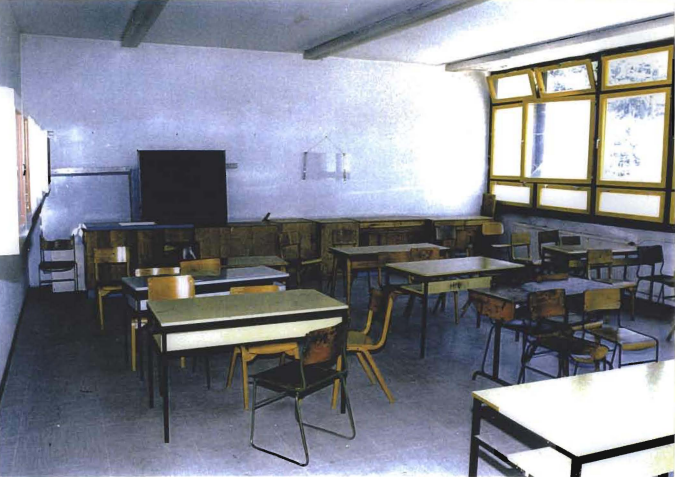
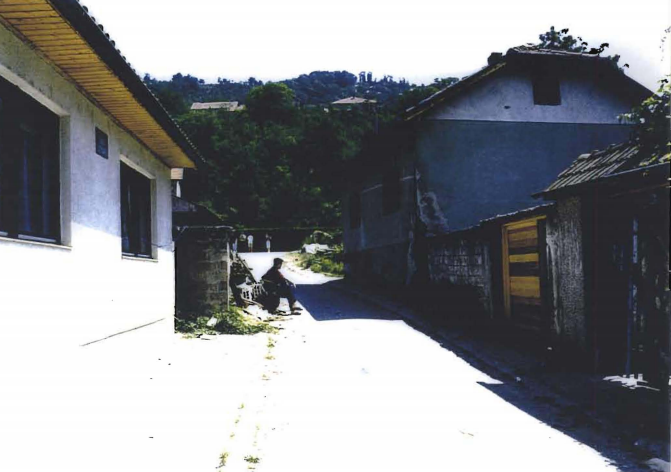
Serb soldiers regularly led many detainees out of the High School Centre and “Partizan” sports hall, and took them to private houses and apartments: the Karaman house, a house at Osmana Đikića 16 street, an apartment in the building called “Lepa Brena”, and a house in the village of Trnovače. Bosniak women from the neighbouring municipality of Kalinovik, where Serb forces kept them detained in the local school, were also brought to these facilities. Serb soldiers continued to rape and abuse them in those houses and apartments. Some of the detainees would be taken back to the main detention facilities within a few hours, while others would remain as sex slaves in those houses for longer periods of time, some for several months. One of the victims, who later testified before the International Criminal Tribunal for the former Yugoslavia (ICTY), made a rough assessment that during the entire period of her detention, which lasted for about 40 days, she had been raped approximately 150 times.
Sexual violence against Bosniak women and girls in Foča was organized and systematic. Some of the victims tried to seek police protection, but their complaints were ignored, and Serb police officers treated them harshly and violently.
Sexual violence against Bosniak women and girls in Foča was organized and systematic. Some of the victims tried to seek police protection, but their complaints were ignored, and Serb police officers treated them harshly and violently.
In mid-August 1992, the women detained at the “Partizan” hall were transported by a bus organised by the Foča police to a refugee camp located in Novi Pazar. Between September 1992 and March 1993, a number of detainees held in private houses and apartments were sold, some managed to escape from captivity, and some were exchanged at various locations between September 1992 and March 1993. One of the youngest victims, a twelve-year-old girl A.B., was sold for 200 German marks and last seen about two months after that.
Detention facility for men
Bosniak men from Foča and surrounding villages were detained in Foča Penitentiary (KP Dom), and some of them remained in captivity for up to two and a half years. Most of the detainees in KP Dom were civilians who had never been charged with any crime. Conditions there, as well as in other detention facilities in Foča, were inhumane: food was scarce, hygiene could not be maintained, and detainees mostly slept on sponges on the floor, without any heating in winter. Not only were the Bosniaks detained at KP Dom starved, they were forced to work, mentally and physically abused, beaten and shot dead.
Serb forces killed over 200 detainees at KP Dom between June and December 1992. Also, groups of detainees, usually younger people, were taken from the Penitentiary under the pretext of going for an exchange, but only in a few cases did the exchange actually take place, and the other detainees were never seen again.
Selection of Documents
In 1993, the Humanitarian Law Center researchers recorded the testimonies of some of the Bosniak refugees from Foča, in the Kirklareli refugee camp in Turkey.
A large number of survivors from Foča, former detainees, testified before the ICTY and the Court of BiH.
The Dikonja Family’s statement was given to the Humanitarian Law Center (HLC) on 17 March 1993 in the Kirklareli refugee camp, Turkey.
Researcher: Filip Švarm
Description of the Dikonja Family’s testimony:
Ibro and Rukeja Dikonja, and their daughter and three sons, lived in the settlement of Donje Polje in Foča. When Serb forces entered the settlement on 26 or 27 April 1992, the family took refuge in the basement of the Kovač brothers, where 18 Muslims and seven Serbs were hiding. After two days, having heard that Arkan’s Men (“Arkanovci”) were coming, some of them headed towards the hospital. Along the way, two Bosniaks were arrested by local Serb soldiers and taken to the Foča KP Dom. In a group of about a hundred Bosniaks and Serbs, Ibro, Rukeja and the children headed towards the city centre. Volunteers from Serbia and Montenegro (the “Serbian Guard”) placed everyone in the “Zelengora” Hotel. They mixed ethnicities between themselves in the rooms, in order to avoid a room with only Bosniaks in it. After two days, the paramilitaries told them that they could return to Donje Polje. Their house had been burned down, so Ibro, Rukeja and the children slept at their cousin Vejsil Delić’s place;
during the day they stayed with another cousin Bećir Dikonja. On June 7, Serb soldier Novica Tripković, drunk and in possession of a baseball bat, entered the house of a 75-year-old Bosniak woman who lived alone. After his departure, they found her dead, and concluded from her clothes that she had been raped. Tripković was reported to the police, who arrived to conduct an investigation, but did nothing. Novica Tripković then reappeared on June 24, and killed Vejsil Delić. Rukeja went to the police to ask for permission to move out, but ran away when the officer asked her, “How come your husband and sons are not in the KP Dom”. The Kovač brothers lodged them again. Neighbour Branko Blagojević also defended them from Serb soldiers. The Dikonja family left Foča on 13 August 1992, with ICRC permits. The next day, the last Bosniaks left Foča in an organised convoy.
Witness 33 testified before the ICTY in the Kunarac et al. Case on 21 and 22 March 2000.
A Bosniak woman from Foča, a pediatrician by profession. She worked as a doctor in the hospital in Foča and as a teacher at the Medical School. The witness spoke of the harmonious relations between Serbs, Bosniaks and Croats in Foča before the 1990s: “It was a Little Yugoslavia.” In the early 1990s, national parties (the Serbian Democratic Party and Party of Democratic Action) were formed, and that is when the ethnic divisions began, along with the war-mongering rhetorics. There was talk of arming Bosnian Serbs throughout Bosnia and Herzegovina, and many Serb women and children left Foča, moving mostly to Montenegro and Serbia. Witness 33 was mostly hidden in the basement with her family and friends during the attacks by Serb forces on Foča from April 8 to 14, 1992. On April 14, armed uniformed men took her and her neighbours to hangars in Livade (a settlement on the east side of Foča) and drew up a list of all of them, after which the Serbs were able to return to their homes, whilst the Bosniaks were taken to the Foča Penitentiary (KP Dom) – including Witness 33.
She and her two children were held captive for a total of 10 days, and her husband for 12 days. After being released from KP Dom, she stayed in Foča for two months. She continued to work at the hospital, but did not receive a salary. As from May 20, all Bosniaks were banned from working at the hospital. After her husband had been released from KP Dom, he had to report to the police station twice a day at a specific time, when he was humiliated and sometimes physically abused. Witness 33 heard that her apartment had been set on fire on the same day they were taken into custody, as she herself later determined. Bosniak houses were set on fire and all mosques were demolished, including the Aladža Mosque built in the 16th century, which was under UNESCO protection. A large part of the Bosniak male population was taken to camps. The movement and gathering of Bosniaks were restricted, their phone lines were cut off, and some were denied the right to medical treatment. Witness 33 and members of her family received permission from the police station in charge that they could leave Foča, but had to sign a statement that they were leaving all their property to the “Serb Republic”.
Witness 50 testified before the ICTY in the Kunarac et al. Case on 29 and 30 March 2000.
A Bosniak woman from the village of Mješaji (Foča municipality), who was 16 years old in 1992. Her village was attacked on July 3, 1992. At the time, she was hiding with her family in a nearby forest, where they were captured by Serb soldiers on the night between July 3rd and 4th and taken to Buk Bijela (a temporary detention facility). She was raped by Zoran Vuković in one of the barracks in Buk Bijela. Witness 50, along with other detainees, was taken from Buk Bijela to the Foča High School Centre, where she was raped the next evening by an unknown soldier. After 11 days, she was transferred to the “Partizan” sports hall, from where
she was taken by Serbian soldiers on several occasions and led away to different locations. Among those who raped and sexually abused her were Zoran Vuković and Dragoljub Kunarac. Vuković once told her after the rape that he would spare her, because she was the same age as his daughter: “He said that he could perhaps do more, much more, but that I was about the same age as his daughter, and so he wouldn’t do anything more for the moment.” Witness 50 did not dare to try to leave the “Partizan” sports hall because Serb soldiers were all over the city: “Any one of them could have killed me at any time, or done something else to me.” She was released on August 13, 1992, when the detainees were taken by a bus organised by the Foča Police, first to Montenegro and then to Novi Pazar.
Witness 62 testified before the ICTY in the Kunarac et al. Case on 27 March 2000.
A Bosniak woman from Mješaji (Foča Municipality), a shop owner, mother of three children and grandmother of Witness 50. After the attack on their village, she and her family hid in the woods, where they were captured by Serb soldiers on July 3, 1992, and taken by them to a temporary detention facility in Buk Bijela, where her husband was killed. From Buk Bijela, she was taken to the Foča High School Centre, and then to the “Partizan” sports hall.
Witness 62 speaks about how Serb soldiers took younger detainees out of the High School Centre, and how they brought them back tortured and in tears. Witness 95 confided in her that she had been raped and abused, and Witness 62 saw that her body bore wounds from extinguished cigarettes. She was present in the “Partizan” sports hall when a soldier raped a detainee next to whom she slept, in front of her ten-year-old son. She was released on August 13, 1992, when the detainees were taken on a bus organised by the Foča Police, first to Montenegro and then to Novi Pazar.
Witness 75 testified before the ICTY in the Kunarac et al. Case on 30 March and on 3 and 4 April 2000.
A Bosniak woman from the village of Trošanj (Foča Municipality). Before the war, she worked in the „Šipad Maglić” factory, and in 1992 she was 25 years old. When her village was attacked, early in the morning of July 3, 1992, she was hiding in the woods with her family and other locals. While fleeing from the Serbian army, several people were killed, including her mother. Witness 75 was taken to a temporary detention facility in Buk Bijela, where she was raped by more than 10 soldiers, and then to the Foča High School Centre, where she spent approximately 15 days. She was raped by Dragan Zelenović and another man at the High School Centre, and from there she was taken to different locations where she was also raped.
She was usually taken to these locations by Dragan Zelenović. She was transferred from the High School Centre to the “Partizan” sports hall. From “Partizan”, together with other detainees, she was taken to a house at 16 Osmana Đikića Street, and to the Karaman house, where they were raped and abused. Serbian soldiers gave them Serbian names and did not allow them to address each other differently. They forced them to cross themselves, threatening to cut off her hand because she did not know how to cross herself. After about three months in captivity in the Karaman house, Witness 75 was transferred to Radomir Kovač’s apartment in the „Lepa Brena“ building, and then to several other private houses and apartments in Foča where the abuse continued. Among the soldiers who raped her during her captivity were Dragoljub Kunarac, Radomir Kovač and Zoran Vuković. She fled on March 5, 1993, with the help of two Serbs.
Witness 127 testified before the ICTY in the Kunarac et al. Case on 5 April 2000.
A Bosniak woman from the village of Miljevina (Foča Municipality), the mother of the missing A.B. In June 1992, two armed police officers came to pick up her husband and take him away as a prisoner. She has never seen him since, nor has she heard anything about him. The daughter of Witness 127, A.B., who was 12 at the time, was taken by a man called Jego from their house to the Karaman house, from where Pero Elez returned her two days later. On September 3, 1992, Witness 127 and her three daughters were expelled from Miljevina and taken by bus to the “Partizan” sports hall, together with about 200 Bosniaks from Miljevina. Serbian soldiers searched them in “Partizan” and confiscated their valuables,
and then put them back on the buses. A police car stopped the bus carrying Witness 127 and her three daughters at the bridge on the Drina in Foča. Her eldest daughter, A.B., was called out by name and taken off the bus. After that, Witness 127 never saw A.B. again. According to the testimony of Witness 50, A.B. was taken off the bus by the VRS soldier Radovan Stanković. She was taken to the Karaman house, and then to an apartment in the “Lepa Brena” building. She was often raped at both locations – by Radomir Kovač and Gojko Janković, among others. In December 1992, Radomir Kovač sold her to a certain Dragec for 200 German marks. Dragec “rented out as prostitutes” A.B. and Witness 75. After she had spent some time in Dragec’s apartment, Jasko Gazdić took A.B. away, and no one saw her again after that.
Witness 139 testified before the ICTY in the Krnojelac Case on 31 October and 1 November 2000.
A Bosniak from Foča, who worked as a guard at the Foča Penitentiary (KP Dom) before the war. He testified that a few days before the beginning of the armed conflict in Foča, in April 1992, about 100 prisoners, mostly Serbs, escaped from prison, and that the warden of KP Dom allowed it. When the combats in Foča stopped in mid-April, Witness 139 did not return to work because Serb soldiers would not allow him to move freely. Only Bosniak women were allowed to go to the store, while the men were not allowed to move around the town. Members of the Serb military police arrested him at his home on May 20, 1992, and took him with four other Bosniak civilians to KP Dom. He remained there until October 6, 1994. According to Witness 139, there were about 600 detainees in KP Dom, almost all of whom were Bosniaks. The living conditions in KP Dom were inhumane. There was no heating, and so during the winter the detainees suffered from severe chilblains and cracked skin.
They could not take regular showers or maintain personal hygiene – they spent all the time in the same clothes they were wearing when they were brought to KP Dom. They received three meals a day, but the meals were small and of poor quality, as a consequence of which Witness 139 lost over 20 kilograms in the first two to three months of captivity. According to his testimony, there were also cases when detainees died because they did not receive adequate medical care. Some detainees were taken to the administration building or the guard building and beaten. The guard would come to the door of the room, call out a certain detainee and take him away. After a few minutes, moans and beatings would be heard, as well as the curses of those who beat the detainees. In addition, 50-60 detainees were taken away for forced labour – plum-picking – and never returned. According to Witness 139, from the start of his detention until October 1993, the warden of KP Dom and the supreme authority in this detention facility was Milorad Krnojelac. His deputy was Savo Todović, who had more direct contact with the detainees than Krnojelac.
Witness 54 testified before the ICTY in the Krnojelac Case on 7 November 2000.
A Bosniak who lived in Foča, in the settlement of Donje Polje, and, before the war, worked as a shift manager in a factory. Donje Polje was shelled, and when the shelling ceased, houses that were not destroyed by shelling were set on fire. During the armed conflict in Foča in April 1992, he hid in the basement of his building. He was arrested on April 16, 1992, in the settlement of Čohodar Mahala, where he was staying at his daughter’s house. He was arrested by Serb soldiers he had not known before, and taken to the Foča Penitentiary (KP Dom). Witness 54 never learned why he had been arrested; nor was an indictment filed against him. He spent 136 days in detention at KP Dom. Owing to the meagreness and poor quality of the meals in the camp, he lost 37 kilograms. He was once beaten in solitary confinement, to which he was taken because he had given another detainee one slice of bread more than was allowed. Witness 54 testified that detainees were taken from the room where they slept to the administration building,
and would return with severe injuries – bruises on the head and body, broken teeth. On 25 June 1992, five detainees – Kemal Dželilović, Mustafa Kuloglija, Hamid Ramović, Enes Uzunović and Munib Veiz – were taken to a room in the administration building. There, they were first beaten, and then killed with a firearm. Witness 54 saw the murder from the room where he was detained, and after that he heard the sound of a car, which he presumed served to take away the bodies of those who had been killed. He attended the removal of several detainees from the rooms where they were sleeping. Among them were Alija Altoka, Refik Čankušić, Enko Čedić, Mate Ivančić, Fuad Mandžo, Kruno Marinović, Nurko Nišić, Zulfo Veiz and others. Witness 54 did not see the killings, but the ICTY established in the Krnojelac Case that all of them (as well as other detainees) were killed in KP Dom. According to this witness, Milorad Krnojelac was the warden of KP Dom during the time of his detention, and this was generally known. Witness 54 was released on 31 August 1992, and taken by bus to Rožaje, Montenegro, with 35 other detainees.
At the end of 1994, the last detained Bosniaks who were still in KP Dom were exchanged. Serb forces destroyed all the mosques in Foča, and expelled the surviving Bosniaks, thus creating an ethnically pure Serbian area. Before the war, Bosniaks made up about half of the population of Foča municipality; but according to the ICTY prosecution evidence, only a dozen Bosniaks were still remaining in the town of Foča at the end of the conflict. At the beginning of 1994, the Assembly of the Republic of Srpska changed the name of Foča to Srbinje, and it took ten years to restore the name Foča.
By 2002, 375 bodies which were exhumed in the area of Foča had been identified. All but one belonged to Bosniaks.
There are few Bosniak returnees in Foča, especially in the town itself. In recent years, murals celebrating Ratko Mladić, Chetnik commander Draža Mihailović, and the recently deceased Milorad Pelemiš, commander of the 10th sabotage detachment of the Main Staff of the VRS, can be seen on the streets of Foča. In 2010 the Humanitarian Law Center filed a criminal complaint against Pelemiš for the genocide in Srebrenica, which was never acted upon.
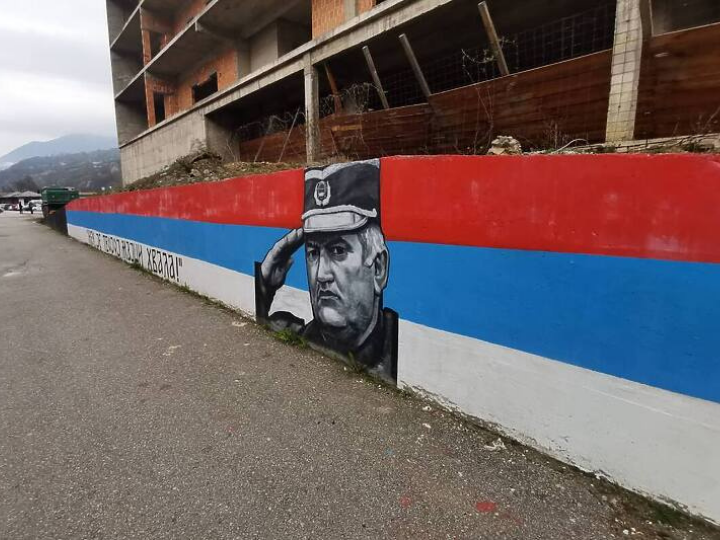
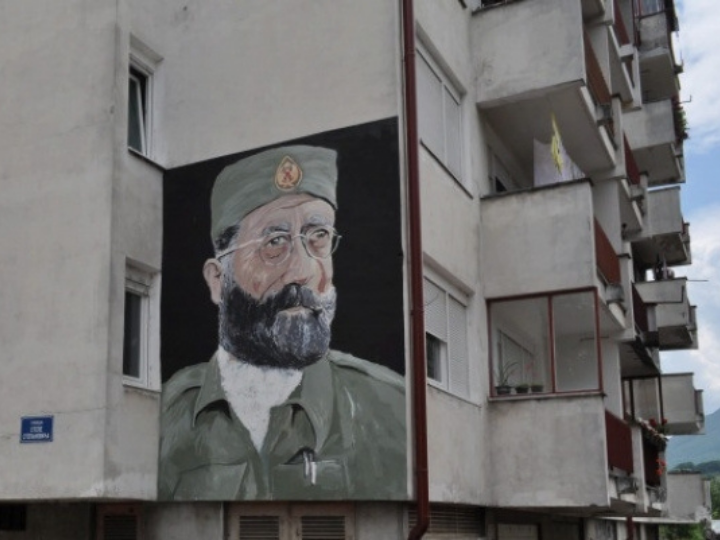
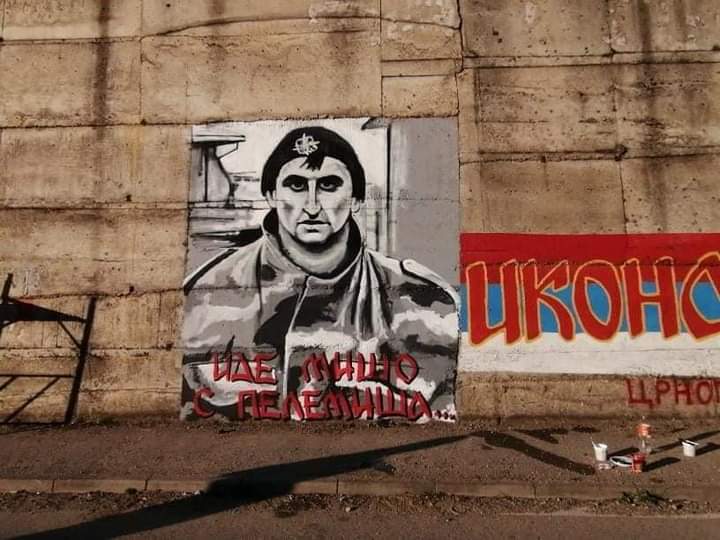
The trial before the ICTY in the Kunarac et al. Case represents a turning point in international criminal law, because it expanded the scope of “enslavement as a crime against humanity” to include sexual enslavement. Thanks to this and other ICTY cases dealing with sexual violence, it has been acknowledged that rape is not only a side effect of armed conflict, but also a powerful tool of war used to intimidate, persecute and terrorise.
The ICTY convicted the following people for the enslavement and rape of Bosniak women in Foča, as crimes against humanity and war crimes: Dragoljub Kunarac, commander of the VRS reconnaissance unit that was part of the Foča Tactical Group, to 28 years in prison; Radomir Kovač, Deputy Commander of the VRS Military Police and leader of the paramilitary forces, to 20 years in prison; Zoran Vuković, Deputy Commander of the VRS Military Police and leader of the paramilitary forces, to 12 years in prison; and Dragan Zelenović, member of the VRS and de facto military policeman, to 15 years in prison. Dragan Zelenović pleaded guilty to all charges, including the torture and rape of several Bosniaks from Foča. The ICTY convicted Milorad Krnojelac, the warden of KP Dom in Foča from April 1992 to August 1993, to 15 years in prison on the charge of torture, murder, persecution and other crimes against humanity and war crimes against Bosniak men.
For the crime against humanity involving the forcible detention, torture and rape of Bosniak women in Foča, the Court of BiH convicted the following persons: Gojko Janković, Deputy Commander of the VRS Military Police and paramilitary leader, to 34 years in prison; and members of the VRS, Neđo Samardžić, to 24 years in prison, Radovan Stanković, to 20 years in prison, Jasko Gazdić, to 17 years in prison, Krsto Dostić, to 10 years in prison, Miodrag Nikačević, to 10 years in prison, Milan Todović, to 10 years in prison, Novica Tripković, to eight years in prison, Milomir Davidović, to seven years in prison, Žarko Vuković, to seven years in prison, and Saša Ćurčić, to five years in prison. The Court of BiH convicted Savo Todović, deputy warden of KP Dom, on the charge of crimes against humanity against Bosniak men in KP Dom to 12 years in prison, and Mitar Rašević, commander of the guard at KP Dom, to seven years in prison. Seven other VRS members have been indicted before the Court of Bosnia and Herzegovina for crimes against Bosniak civilians in Foča. The Sarajevo Cantonal Court convicted Veselin Čančar, a member of the VRS, to four years and six months in prison for war crimes against civilians in Foča.
The crimes committed by Serb forces against Bosniak civilians from Foča and surrounding areas were also part of the indictments in the cases against Radovan Karadžić, Ratko Mladić, Biljana Plavšić and Momčilo Krajišnik. They were convicted before the ICTY for these crimes, as acts committed as part of a joint criminal enterprise.
Kunarac et al. (ICTY)
The trial judgment of February 22, 2001 and the appeal judgment of June 12, 2002
Dragan Zelenović (ICTY)
The trial judgment of April 4, 2007 and the appeal judgment of October 31, 2007
Milorad Krnojelac (ICTY)
The trial judgment of March 15, 2002 and the appeal judgment of September 17, 2003
Gojko Janković (The Court of BiH)
The trial judgment of February 16, 2007 and the appeal judgment of October 23, 2007
Neđo Samardžić (The Court of BiH)
The trial judgment of April 7, 2006 and the appeal judgment of December 13, 2006
Radovan Stanković (The Court of BiH)
The trial judgment of November 14, 2006 and the appeal judgment of March 28, 2007
Jasko Gazdić (The Court of BiH)
The trial judgment of November 9, 2012 (BCS only) and the appeal judgment of June 17, 2013
Krsto Dostić (The Court of BiH)
The trial judgment of October 6, 2016 (BCS only) and the appeal judgment of January 17, 2017 (BCS only)
Miodrag Nikačević (The Court of BiH)
The trial judgment of February 19, 2009 and the appeal judgment of July 12, 2010
Milan Todović (The Court of BiH)
The trial judgment of December 4, 2018 (BCS only) and the appeal judgment of March 12, 2019 (BCS only)
Novica Tripković (The Court of BiH)
The trial judgment of June 7, 2011
Milomir Davidović (The Court of BiH)
The trial judgment of February 27, 2019 (BCS only) and the appeal judgment of July 9, 2019
Žarko Vuković (The Court of BiH)
The trial judgment of October 11, 2017 (BCS only) and the appeal judgment of January 19, 2018 (BCS only)
Saša Ćurčić (The Court of BiH)
The trial judgment of September 14, 2020 (BCS only) and the appeal judgment of December 21, 2020 (BCS only)
Rašević et al. (The Court of BiH)
The trial judgment of 28 February 2008 and the appeal judgment of 6 November 2008
Veselin Čančar (The Sarajevo Cantonal Court)
The trial judgment of January 12, 2005 (BCS only)
